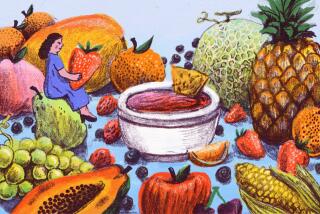Hot Peppers Pack a Lot of Punch : The fruit ranges from mild, sweet varieties to those fiery enough to sear the palate. Many are grown locally.
- Share via
The hot pepper--long the ingredient that puts flavor and fire into salsa--has become a staple for California cooks, especially those interested in cuisines beyond our borders.
“There really is no style of food anymore--it is so international and so mixed,” said Ojai restaurateur Suzanne Roll, who purchases locally grown peppers weekly for the kitchen of Suzanne’s Cuisine. “Asian and Southwestern influences--which of course utilize lots of hot peppers--have become prominent and are used extensively.”
Chilies are an easy commodity for Ventura County shoppers to come by year-round--especially during summer months when they are harvested locally.
Not only do the grocery chains offer a few of the more common types, but the area’s ethnic stores and farmers’ markets are an excellent source for a large variety of fresh and dried hot peppers.
La Gloria Market in Oxnard may be the best spot of all for the dried version. Here you’ll find an impressive, aromatic display of more than 10 different types of chilies, all in large quantity. Running the gamut from mild to super hot, La Gloria’s dried chilies cost anywhere from $3.85 to more than $15 per pound.
Grocery manager Jose Mendoza said all of La Gloria’s dried chilies are imported from Mexico.
“Our most popular chili is the pasilla , which is used mainly for salsas and menudo,” Mendoza said. A dried pasilla , similar to a large dried fig, is one of the more tame varieties and imparts almost a sweet spiciness to salsa preparations, Mendoza said. At the other end of the heat spectrum, the red-hued arbol-- a few inches long and string bean-like--is popular for fueling recipes with fiery hotness, he said.
“The most expensive chili we have is the chipotle ,” Mendoza said. Even at $15.29 a pound, this brown leathery two-incher won’t cost that much--with its intense heat, you won’t need to purchase big quantities.
Although plentiful quantities of certain chilies remain inexpensive throughout the year, Mendoza said the chipotle commands a high price because of its exclusivity. “It is grown in a special area in Mexico and can be very hard to get,” he said. “It is especially good for making adobo (a type of salsa), which is used with meats.”
Other varieties at La Gloria market: chile negro (deep black, elongated), habanero (gold, plum-sized and very hot), cascabel (dark colored, cherry-shape), California (blood red, elongated), japones (red, small and slender) and guajillo (similar to a California).
While the dried chili versions offer convenience (Mendoza said they keep for long periods and need not be refrigerated), fresh hot peppers are preferred for such preparations as chile rellenos and vegetable sautes.
Commonly seen in grocery stores are fresh versions of the extra hot serrano (green, slender, two inches long), Anaheim (mild, greenish or red, elongated) and maybe the most widely known hot pepper of all, the jalapeno.
If you do your veggie shopping at the local produce markets, you may be familiar with the offerings of the Beylik family. Long known for their hothouse tomatoes and European cucumbers, Beylik Farms has recently switched to peppers--hot and sweet types--as their main commodity. Nudged out of the tomato-cucumber market because of increased competition, the Beyliks have created a new market niche for themselves, built around the pepper’s ever-increasing popularity.
“We’re able to sell our peppers year-round because we grow them hydroponically indoors,” said Linda Beylik, whose husband, Bob, maintains a number of greenhouses in Fillmore.
A colorful assortment of their peppers can be had at Ventura’s Saturday and Wednesday markets and the Thursday market held in Thousand Oaks. The Beyliks offer such varieties as the hot Hungarian, jalapeno, Anaheim and Italian frying pepper--which has a mildly spicy, yet sweet flavor.
Ojai grower Russ DiLando thinks he may have the hottest pepper of them all--the tiny red Thai pepper.
“This thing is only as big as your finger tip, maybe three-fourths of an inch long, but very, very hot,” DiLando said. “I really have to warn people--if you touch them, keep your hands away from your eyes and nose.”
DiLando, who attends the Ventura Saturday market, said the Thai pepper is used mainly as a seasoning agent and not eaten. “You only need to toss one of these around in a wok and it really spices things up,” he said.
And just what causes a pepper to sear our taste buds?
The incendiary ingredient is called capsaicin--and it is highly concentrated in a pepper’s central membrane, which holds the seeds. To douse some of the pepper’s fire, simply remove--without touching it--the membrane before preparing your chosen recipe.
More to Read
Eat your way across L.A.
Get our weekly Tasting Notes newsletter for reviews, news and more.
You may occasionally receive promotional content from the Los Angeles Times.










